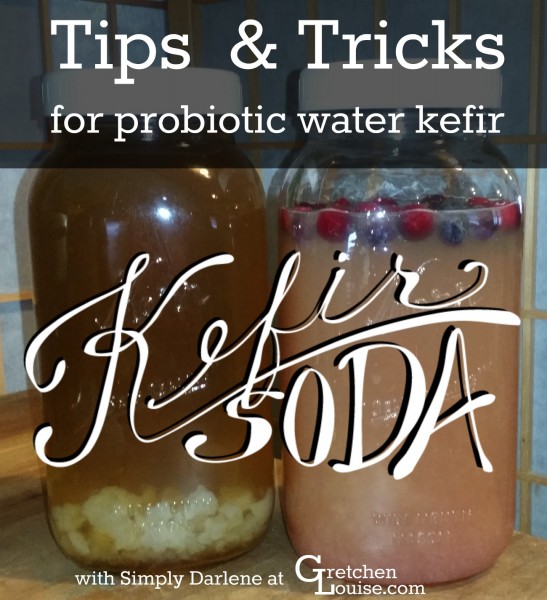Probiotic Water Kefir: Tips & Tricks
(This post contains affiliate links. Read my full disclosure.)
Water kefir (or kefir soda) is one of my favorite probiotic beverages. I like to drink it with my meals to aid in digestion. I love knowing that I’m getting all sorts of good bacteria that are great for my immune system, without all the sugar of fruit juice, or the chemicals or a carbonated beverage.
When I first began exploring the use of natural probiotics, my friend Darlene was an invaluable resource. Not only did she give me my first batch of kefir grains, but she’s been there to answer all my questions along the way.
I asked Darlene if she’d join me here on my blog to talk about kefir soda. She’s sharing her answers to some of the questions I asked her, as well as the concerns some of you have voiced in your comments on my 5 minute guide to kefir soda.
And if you have more questions? The comment box is always open! Darlene or I will do our best to answer.
a conversation about kefir soda
with natural health educator Simply Darlene
Gretchen: How long have you been brewing water kefir? How were you introduced to this amazing natural probiotic?
Darlene: I’ve been cluttering countertops and swigging down kefir soda off and on for about four years. A health-conscious friend introduced me to dairy kefir when she mailed me directions and a glob of starter. Being a vegan, water kefir fit my lifestyle better than its dairy counterpart, so I made the switch.
Cold water, hot water, I hear all sorts of directions. If hot water kills the kefir grains, does lukewarm water just jumpstart the brewing process?
I take the middle ground with warm. Actually, I looked at other ferment processes to determine how things have been done over the years. Warm water seems the most common. Plus, that’s the temperature of fermentation on your countertop.
It seems strange to be putting all this sugar in a “healthy” drink. How much sugar remains in the brewed kefir soda?
During both ferment stages, the kefir feeds off of the sugar and produces helpful bacteria, yeast and minerals. In the first ferment, the sugar is sugar — sucrose. In the second ferment, the sugar is fruit sugar — fructose. If your kefir ever tastes sweet, like a weak sweet tea, it’s a fail. When done right, only minute amounts of sugar remain because the culture has “eaten” it. As an insulin-dependent diabetic, water kefir has had no impact on my blood sugar levels. That being said, blood sugar fluctuations vary from person to person. Each must determine the impact (or lack thereof) on his/her own blood sugar levels.
Do different types of sugars impact the taste and/or health benefits of the finished product?
Yes. Even though some folks use white sugar or even powdered sugar, I opt for an organic, whole cane sugar such as Sucanat or Turbinado (brand names). It’s a healthy drink; why not make it from the most pure ingredients?
I know I’m not supposed to use honey in my water kefir. Why?
Raw honey is high in healthy bacteria and likely will kill the kefir cultures.
I’ve read that some people put a rinsed eggshell in their first culture. Others mention baking soda, molasses, and so on. What do these do to my kefir?
In addition to kefir being high in good bacteria and yeast, it has a goodly amount of minerals too. If your kefir culture process has slowed and/or you are starting out with a new batch, it’s a good idea to jumpstart the process with a mineral source. Personally, I use organic blackstrap molasses.
How much solid fruit do you add to the second culture? Is the amount different for fruit juice?
Just like some of the other variables (i.e. water temperature and sugar source), the amount and the type of fruit for the second ferment is optional. But to keep things easy, I focus on The Kefir 3’s: about 3 tablespoons of dried fruit or smashed fresh fruit per 32 ounces.
How long do you usually let each ferment go? I’ve read you can let the second “flavoring” brew go up to 7 days on the counter.
Wintertime: 2-4 days. Summertime: 1 day. I reckon 7 days would give you a whiz-bang whallop! It depends on your kefir culture, sugar source, fruit, and the temperature of your home. My basic rule is to look for some fizzy action (even as soon as a couple of hours in the summertime) when I slightly tip the jar. That’s an indication that the kefir is eating the fruit sugar.
I’ve tasted some of your amazing kefir soda concoctions. I think the elderberry might have been my favorite. What are some of your own favorite combinations?
There are so many variables, but my basic ingredient system is this:
For the first ferment I use 32 ounces of warm water (hard water from our well), 1/3 cup water kefir grains, 1/3 cup of organic Sucanat. And for the second ferment I add 1/3 cup of dried fruit (organic elderberry being my favorite, smashed raw strawberries with raisins being a runner-up).
I’ve heard I should keep my kefir away from direct sunlight. Does that mean it needs to be in a dark corner of my kitchen? Or is on a shelf near a window but covered with a towel okay?
Basically, you need to keep it out of direct sunlight. On your kitchen counter, in the cupboard, or on a shelf – wherever floats your boat.
I know using metal containers or utensils is a no-no. But other places I’ve read that stainless steel is okay. What do you think about that? And are metal lids okay as long as there is no direct contact of the kefir with the metal?
Ah, another variable! I’m simple, simple, simple (mainly because I confuse easily) so for me, “no metal” means no metal, even stainless steel. Even though I prefer the Ball brand plastic storage caps, I have used metal lids. I keep the liquid level well below the lid line and take care not to jostle the kefir against the lid during the fermentation process though.
What about tossing my kefir in my smoothies? Is it bad for it to contact with the metal blades of my VitaMix blender?
Actually, lots of folks do this, even with their grains. If this method is the only way you can get yourself and/or family members to drink probiotic-laden kefir, do it. Just drink the product immediately so you retain as many health benefits as possible.
My grains vary a lot in size; a few are even as wide as quarters. Some friends say their grains rapidly multiply but remain the size of rice grains. Does size indicate age or effectiveness?
Though some grains continue to grow an inch or two wide without breaking apart, they tend to naturally adjust according to season and age. But according to Yemoos Nourishing Cultures, smaller kefir grains are actually more consistent in flavor, as well as more productive because of the greater amount of exposed surface area. (They do note that extremely small grains may indicate stress, heat, or rapid reproduction.)
I always seem to have a bit of “sediment” in the bottom of my second culture. Is that just tiny kefir grains and/or fruit?
You’ll find this same grayish film in store bought kefir water products, as well. It is part of the process. I make sure to gently swirl the water so I get all that health-laden gunk in my glass and down the gullet into my gut.
I often culture both milk kefir and water kefir. Do I have to worry about any contamination or cross culturalization?
As with any ferment process, whether it’s water kefir, dairy kefir or sourdough, you must use cleanliness in your utensils, jars, lids, countertops and hands. I’d work with only one fermentation product at a time and keep them on separate counters.
What’s the low-down on the alcoholic content of cultured kefir? I know it’s going to vary per batch, but is it safe to drink during pregnancy?
Overall, the bacteria in kefir limit its production of alcohol, thus converting the produced alcohol into beneficial acids.
According to data gathered from Yemoos Natural Cultures, Cultures for Health, and Nourished Kitchen, overripe fruit contains about 1% alcohol, beer 4-7%, and wine 8-14%; whereas water kefir contains anywhere from .038% to 2% alcohol, with the average alcohol content being .08% or less at a typical 48-hour ferment.
But, the longer the kefir is tightly sealed during its second fermentation, the more it will increase in alcohol (up to 3%).
As for use during pregnancy, one should ask their midwife and/or doctor.
How much kefir should I drink? Is it possible to drink too much kefir soda?
Well, it is a combo meal deal of bacteria and yeast so if a person suffers from acute or chronic candida, it’s probably not a good idea to drink more than a couple of ounces per day, if that. My own momma drinks a quart per day. As with anything new, start small and remember that moderation is best.
I know that natural cultures are hard to compare, but how do milk kefir and water kefir differ in quantity and quality of cultures?
Both are probiotic in nature. The milk kefir is more akin to yogurt and the water kefir to kombucha. Those who battle candida would probably benefit more from the dairy kefir.
A lot of my friends brew kombucha. How does kefir soda compare?
Whereas both products have probiotic benefits and are great for digestion, Kombucha is more of a cleanser and detoxifier, especially with the liver, while kefir is a stronger probiotic, filled with beneficial microbes that are great for the immune system, but without the detox effect.
Kombucha contains caffeine, and kefir has more naturally occurring alcohol. Kombucha may also be a concern for those with Candida or excess mercury in their system. And, kefir is traditionally considered a good probiotic for diabetics. (Click here for more complete technical details about water kefir vs. kombucha.)
I know sometimes you buy a bottled kefir type product called Kevita. How do you feel it differs in health benefits from homebrewed water kefir?
As with any homemade food or culture, I know for certain what products were used in my countertop creation, and since it’s not pasteurized, I know mine has the highest possible content of bioavailable bacteria, yeast, and minerals. Also, I have way more greenbacks in my pocket with the homebrew variety. But in a pinch, or whilst traveling, the store-bought Kevita is fine and dandy.
Help! What do I do with all my extra kefir grains? I think I’ve shared them with all my local friends at least once. Can I feed them to my chickens?
If yours grow at the rate of mine, you will end up with a gallon of kefir grains every 4 days! Help, indeed. Add them to the compost bin; dehydrate them for future use and/or as a way to mail them to non-locals; blend them with some water and fertilize garden and indoor plants (beware because your critters might fancy the smell); feed them to your chickens; instead of birdseed, throw them at newlyweds as they exit the church.
For more tips, be sure to check out Gretchen’s 5 Minute Guide to Kefir Soda.

Please Note: Even though she has an extensive background and training in the natural health industry, Darlene takes no responsibility for your use or misuse of kefir. Kindly remember that Simply Darlene is not a doctor, nor does she play one out here in BlogLand.




Hello, I have been using water kefir grain for about 2 years now. first starting out with 1 fermation and enjoying the health benefits. shortly after I decided to try the 2nd fermentation process and enjoyed the carbonation much more than the plain water kefir previously.
At first I mixed 1/2 kefir water and fruit juice and then noticed that there was a residual coating on the bottom of my bottles. As I continued to use 100% juice at this time and leaving the sediment in the bottle and not making any kefir water,I found the residual on the bottom of the container(I’m assuming it’s yeast and good bacteria) would give me a carbonated and tasty beverage.
My question is …is the sediment at the bottom of the bottle in fact yeast and bacteria and will it yield the probiotics as if I used Kefir grain?…Thanks for your time, Mike H
I’m just starting out and I am having some trouble with the first fermentation process. I keep getting the kham yeast (I think thats what it’s called) on the top. I have read this is bad and to wash the grains off and start new. They are now chilling in the fridge with some sugar water until I start my next attempt. If you could give me some advice that would be great!
Hi, i have been brewing water kefir for about two month. I use 1/2 cup of organic sugar to w quarts of spring water. I let it brew for 5 days before the second fermentation. I use about 1/3 cup of juice and let that ferment for a couple of days. I find the kefir delicious but seems to have more sugar than I think it should. Any suggestions in getting it to be less sweet. I am thinking that I am using too much juice and will be cutting it back. Any suggestions would be appreciated.
How do you travel and take along your water kefir.? I am going to Bali and want to take kefir along. Thank you. Patricia
Now that it is cold outside, can I warm my already made kefir water without compromising its probiotic value?
ok, ive grown no grains, but have great Kifer tea. I started a rd trip to see Grandma for xmas, now its May. i used big plastic tea jugs & dumped my Grain & store bought sweet tea with Cinnimon & Termeric.& keep it in the back of my SUV w/ my Gym gear. its been GREAT! but no new grain- help…
Hi again, This time I’d like to know if there is an ideal low / high temperature for growing water kefir. We’re moving into winter in South Africa and I’m afraid the weather might get too cold.
Many Thanks.
Check out this info from Cultures for Health: http://www.culturesforhealth.com/learn/water-kefir/encouraging-water-kefir-grains-to-multiply/
Hi, I’m a confused newbie.
I’ve been given some water kefir grains. A mistake, I think, I made was to transport it dry. I drained it and put it a “ziplock” bag. it’s been in the bag, in the fridge, for 5 days. will this effect it at all.
The question I have is;
Although the the original culture was made from organic cane sugar, can i use supermarket bought white sugar? the ingredient label states that it contains (per 100g) 99.9g sugar and 1mg sodium.
Your advice will be most appreciated.
Many thanks ans Kind Regards.
Dennis.
If I were you, I’d just try reactivating your kefir grains and see if they still have life in them. You can completely dry them to transport/ship, so being dry for five days wouldn’t hurt them too much, I’d guess.
You can definitely use white sugar now.
Thank you!
Thanks Grethen,
Most incouraging. I’ll give it a go.
Kind Regards.
Dennis
my kefir is not fizzy or fermented tasting at all. new grains and they multiply….1/4 grains, 1/4 c organic cane sugar, water quart jar.
why do you think this is?
thanks
Dawn
How long do you ferment it for? (I do 48 h) Do you do a second ferment out of the fridge? (I do 24 hours). Are the bottles you use air tight? I find sometimes after F2 in a jar on the counter, there isn’t much fizz but most of the time the fizz develops in the flip top bottles in the fridge. If your kefir doesn’t taste like it’s fermenting, your water may not be strong enough in minerals (or does it have chlorine?) You can boil the chlorine out (and let cool before using), add some minerals or try a different water (store-bought Spring water – not distilled). Also to be noted: reverse osmosis water lacks minerals for water kefir. Also adding a date helps feeding the grains.
Yay, great info 🙂
A friend gave me milk kefir grains when we visited the States a few weeks ago, and they survived the plane trip 🙂 They’ve been multiplying very well, and since I had more then I needed I’m attempting to convert them to water kefir now, since culturesforhealth tells you how to do it on theiir website. Curious to see how that goes, and I do hope it works 🙂 In a week I’ll know 🙂
I’ll be curious to hear how that goes! I’d always understood that you could convert water grains to milk grains but not vice versa. 🙂
Funny, the website says the exact opposite. I’ll let you know how it goes 🙂
This is great! Thank you for sharing. It’s been a couple years since I made water kefir so I can’t wait for the grains on my counter to start working.
I hope they come to life soon!
Miss G,
Thanks so much for having me over to your place today. What fun it’s been
Cheers! I can hear the kefir soda bubbling about as we clank glasses. 🙂
Thank you for visiting–and for introducing me to kefir soda in the first place! Yay for friends who help make me more crunchy. 😉